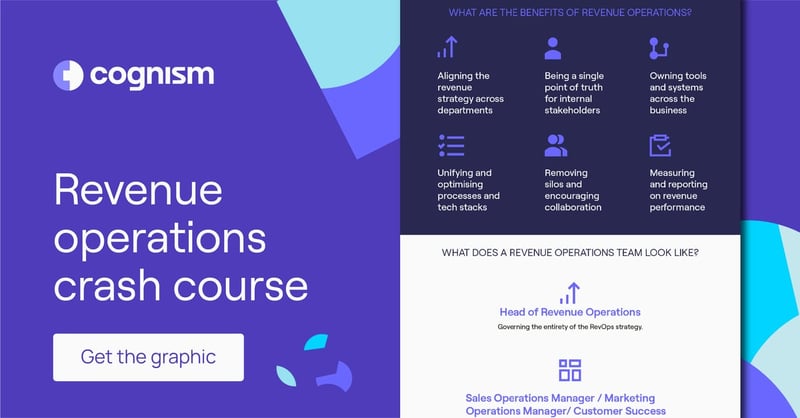What is Revenue Operations (RevOps)?
Revenue operations (RevOps) is a strategic approach that integrates and aligns sales, marketing and customer success to enhance the customer experience and boost revenue growth.
In this guide, we’ll explore the following:
- What RevOps is and why it’s important.
- How it can help your organisation increase revenue and become more profitable.
- How it differs from sales operations and marketing operations.
- How to implement a successful revenue operations strategy at your company.
Scroll 👇 for more!
Why do businesses need revenue operations?
The way B2B companies generate revenue has changed. More focus than ever is on collaboration between marketing, sales, and customer success.
The need for revenue ops comes from the fact that in many B2B organisations, the three teams work together to optimise the customer journey, rather than having their own delineated areas of responsibility.
They also use the same business data and software, so why keep them separate?
For most B2B/SaaS firms, the revenue generation workflow looks like this:
Sales depends on marketing to generate the right leads at the right time. The sales team is concerned with building long-term relationships with a high lifetime value, which impacts the customer success team.
With this alignment comes the sharing of tools and even people, like SDRs in the sales department, who bridge the gap between marketing and sales at the top of the funnel.
RevOps’ job is to facilitate communication between all revenue-generating teams, implement new tools, and improve reaching sales goals. It’s no surprise that publicly traded companies with a RevOps function saw a 71% better stock performance than companies that don’t!
Watch Cognism’s RevOps Review to keep your fingers on the pulse of revenue operations today! 👇
How does RevOps differ from Sales Operations and Marketing Operations?
While revenue operations, sales operations, and marketing operations have some overlap, each plays a distinct role in driving revenue growth.
Sales operations (Sales Ops) support the sales team by providing them with the tools and processes they need to sell effectively.
Sales Ops typically focuses on:
- Optimising the sales process.
- Managing the sales pipeline.
- Improving sales productivity.
On the other hand, marketing operations (MarOps) are responsible for supporting the marketing team. They do this by managing and optimising marketing campaigns.
MarOps typically focuses on:
- Data management.
- Marketing automation.
- Campaign analysis.
RevOps differs from the other two in that it’s a more comprehensive approach; it encompasses both sales operations and marketing operations, as well as other revenue-generating functions such as customer success.
The RevOps function typically includes responsibility for:
- Managing the technology stack.
- Implementing data-driven processes and analytics.
- Coordinating efforts across multiple teams.
- Ensuring a seamless revenue cycle.
RevOps also places a strong emphasis on performance metrics and KPIs, as these drive accountability and ensure alignment with business goals.
What are the benefits of implementing a RevOps strategy?
There are several benefits to implementing a revenue operations strategy in your organisation:
1. Increased revenue
RevOps can help your business generate more revenue and improve profitability by aligning sales, marketing, and customer success.
With a focus on optimising the entire customer journey, RevOps can identify new revenue streams and improve retention rates. This results in increased revenue.
Don’t believe us?
Forrester Consulting found that companies with advanced RevOps strategies achieved up to 10% greater revenue growth over five years.
2. Improved customer experience
One of RevOps’ goals is to create a unified team focused on the customer journey.
It achieves this aim by delivering a seamless and consistent experience across all touchpoints.
This can lead to increased customer satisfaction and loyalty.
3. Enhanced efficiency
By implementing standardised processes and eliminating silos, RevOps improves operational efficiency and reduces costs.
This can free up time and resources for salespeople and marketers to focus on revenue-generating activities.
4. Better data insights
RevOps collects and analyses sales data from multiple sources.
This allows your business to gain insights into customer behaviour and identify areas for improvement.
5. Increased agility
By implementing a flexible and agile RevOps strategy, you can quickly adapt to changing market conditions and customer needs.
This will help your company stay ahead of competitors and seize new opportunities.
6. Improved communication
Revenue operations is the glue that binds sales, marketing and customer success together.
A centralised team overseeing your company’s revenue generation improves communication and collaboration between departments, reducing misunderstandings and improving overall performance.
How does RevOps improve revenue growth and profitability?
Revenue operations helps your organisation achieve revenue growth and profitability in several ways. They are:
1. Aligning sales, marketing and customer success
These teams are not always good at working together; silos exist at many companies.
RevOps is essential to bringing alignment to a business. It creates a cohesive and coordinated approach to revenue generation.
This reduces duplication of effort, improves cross-functional communication, and ensures that everyone is working towards the same goals.
2. Data-driven insights
RevOps relies on data analytics to identify trends and patterns in customer behaviour.
With this information, your company can identify new revenue streams, optimise sales and marketing strategies, and improve customer retention.
3. Process optimisation
With improved processes comes improved efficiency.
Revenue operations is crucial to this. It optimises processes in the following ways:
- Standardising training and internal documents.
- Eliminating bottlenecks in the sales funnel
- Automating workflows where possible.
This also leads to a reduction in costs.
4. Technology enablement
A key element of process optimisation is leveraging technology to automate and streamline tasks.
As custodians of a company’s tech stack, RevOps is vital to this. When salespeople and marketers have the best B2B tech at their disposal, they’re freed up to focus on higher-value activities.
5. Tracking performance metrics
RevOps relies on a set of performance metrics and KPIs to measure success and ensure accountability.
By tracking these metrics, your RevOps team can identify areas for improvement and take action to optimise your processes.
6. Better customer experiences
A consistent and seamless customer experience is something all B2B companies strive for!
A successful RevOps team can help to achieve this, making the buyer’s journey smoother across all touchpoints.
With this, your firm will see improved customer satisfaction and retention.
Check out a guide to revenue operations metrics.
What are the best practices for implementing a RevOps strategy?
Here are seven best practices for implementing RevOps in your business 👇
1. Start with a clear strategy
Before implementing RevOps, it’s vital to develop a clear strategy that outlines your goals, objectives, and approach.
This should include:
- The customer journey across sales, marketing and customer success.
- Internal processes and technology.
- Each team’s key metrics and KPIs.
2. Establish cross-functional teams
Revenue operations must work to break down the silos between departments; one of its key missions is to unify sales, marketing and customer success into one revenue team, sharing common goals.
To this end, establish cross-functional communication between your teams.
3. Invest in technology
Tech is a crucial component of RevOps; the right tools can make all the difference between a successful strategy and a failed one.
Conduct market research and invest in the best technology for your company. Pay close attention to your CRM system, marketing automation tools and analytics platforms.
4. Standardise processes
Your RevOps strategy will only succeed if all your teams follow the same processes.
Follow these steps to ensure consistency:
- Define clear roles and responsibilities for your staff.
- Develop workflows and provide internal training.
- Document best practices and build up your RevOps playbook.
5. Focus on data-driven decision-making
A successful RevOps strategy relies on data to analyse performance and inform decision-making.
Without good data, tracking KPIs, goal setting and forecasting become incredibly challenging.
We recommend working with a reputable B2B data provider to ensure your company’s information is clear, correct and compliant.
6. Encourage continuous improvement
The best RevOps teams foster a culture of continuous improvement. A successful strategy isn’t a ‘set and forget’ exercise; you must review, optimise and improve regularly.
This includes timely performance reviews (for both tasks and individuals), feedback loops, and a willingness to experiment with new approaches.
7. Foster a customer-centric culture
Finally, RevOps requires a focus on the customer experience.
It’s vital to foster a customer-centric culture where all teams focus on delivering a seamless and positive experience for their prospects and buyers.
Get a condensed version of this guide - click 👇 to download our RevOps infographic!
What are the common challenges of implementing RevOps?
Implementing a RevOps strategy can be challenging, especially if the company isn’t used to working in a cross-functional, data-driven way.
Here are some common challenges that RevOps teams typically face 👇
1. Resistance to change
Implementing a RevOps strategy involves changes to processes, technology, and culture. Some team members may find this difficult to accept.
You may encounter resistance to new technologies or changes in roles and responsibilities.
To solve this challenge:
Inform your colleagues of the positive benefits/outcomes of your planned changes. Also, commit to ongoing training for your teams.
2. Siloed data
Sales, marketing, and customer success teams often use different systems and data sources. This makes it difficult to get a complete view of team and customer behaviour.
To solve this challenge:
Invest in a good CRM that all teams can access. In addition, ensure your CRM data is up-to-date.
3. Lack of data quality
Poor data quality can lead to inaccurate reporting and misinformed decisions.
Incomplete, inconsistent, or out-of-date data will negatively impact the accuracy of your forecasting and reporting.
To solve this challenge:
Consider working with a third party that supplies accurate sales and marketing data.
4. Lack of executive buy-in
Undoubtedly, implementing a RevOps strategy requires support from your company’s senior leaders.
Without executive buy-in, it can be difficult to get the necessary resources and support to make meaningful changes.
To solve this challenge:
Provide the C-suite with a roadmap of your planned changes. Your roadmap should include:
- Each step in your plan with anticipated completion dates.
- A fully-costed budget for your plan.
- A list of expected benefits/results.
- A list of potential blockers/challenges and how you could resolve them.
- A glossary of business terms (don’t assume everyone in your org speaks the RevOps language!).
5. Insufficient resources
For revenue operations to work well, it needs resources, including personnel, technology and training.
Not every business will have the people or the cash to invest in these areas. This can slow down your RevOps strategy.
To solve this challenge:
If you’re working at a startup or scaleup - start small. Make incremental changes, prove the value of RevOps, and then request extra resources.
6. Lack of process alignment
Sales, marketing, and customer success teams will likely have different processes and workflows. This can lead to misalignment and confusion.
To solve this challenge:
First, ascertain what the processes used by the different teams are.
Then, work on standardising these processes. Cross-departmental communication will be key here; consider setting up regular meetings to discuss and report on progress.
7. Resistance to data-driven decision-making
RevOps relies heavily on data and analytics to make informed decisions.
Some team members may resist data-driven decision-making or need to develop the necessary skills to analyse and interpret data.
To solve this challenge:
Work with department heads to create training materials for their employees. Remember that everyone learns in different ways, so consider providing training in both print and video formats.
What is the revenue operations team structure?
The size and structure of your revenue operations team will depend on the size and needs of your business.
However, companies that are finding success with RevOps use the following revenue operations org chart 👇
There’s a Director of Revenue Operations, reporting to the CRO.
Reporting to the Director of RevOps, there are managers for each area of operations:
- Sales Operations Manager - overseeing ops for the sales team.
- Marketing Operations Manager - overseeing ops for the marketing team.
- Customer Success Operations Manager - overseeing ops for the CS team.
- Systems Operations Manager - overseeing data and technology implementation.
Under these managers, there may be analysts for each area. Their role is to identify and solve issues relating to business performance. To do so, they must review and analyse vast amounts of data in collaboration with their respective departments.
What skills and expertise are needed in a successful RevOps team?
To be a hit in the world of revenue operations, you need a wide range of skills 👇
- Strategic thinking - the ability to formulate plans and proposals based on delivering the company’s goals.
- A head for figures - in RevOps, everything is based on data and metrics.
- Problem-solving - a key part of the job is to diagnose and remove obstacles that stop your teams from generating revenue.
- Communication - the ability to persuade internal stakeholders that your strategies will benefit their long-term success.
- Technically-minded - you’ll be dealing with complex software and systems; some RevOps roles include coding as a core responsibility.
- Teamwork and collaboration - RevOps can’t be a silo; it demands close association with internal departments. The best RevOps teams work alongside managers and employees to implement changes.
- Customer-focused - even if you don’t talk to customers, you must always have the customer’s needs in your mind. After all, without paying customers, there is no revenue!
Don’t miss Cognism’s RevOps guide, covering all topics from data to metrics and more. Click 👇
What are the key revenue operations metrics?
Revenue operations is a numbers game. Here are some of the metrics you need to know in a revenue operations job 👇
- Sales cycle time - the time it takes from the first touch with a prospect to closing the deal.
- Pipeline velocity - the speed at which leads move through each stage of your revenue pipeline.
- Win rate - the proportion of sales opportunities your sales team converts into customers.
- Customer acquisition cost (CAC) - the total cost of winning a new customer (this metric can include lead gen costs, salaries, equipment and more).
- Annual recurring revenue (ARR) - the revenue coming into your business from subscriptions or contracts, calculated over the course of a year.
- Customer lifetime value (CLV) - the amount of revenue you can expect from a customer during the entirety of your relationship with them.
- Upsells and renewals - the amount of revenue you make from selling new products to existing customers, or getting them to commit to a new contract or subscription.
- Customer churn - the proportion of customers you lose over a specific time period.
Forecast accuracy - a calculation of how predictable your revenue is, usually expressed as a percentage.
What technology can support a revenue operations strategy?
Technology plays a critical role in supporting a RevOps strategy.
Here are the top tools that support revenue operations 👇
1. CRM
The most important tool in your RevOps toolkit!
A CRM (Customer Relationship Management) system is essential for managing customer data, tracking interactions, and automating sales and marketing workflows.
A CRM system provides a single source of truth for customer data; this is essential for making data-driven decisions.
2. Marketing automation platforms
These tools automate B2B marketing campaigns, including email marketing, social media scheduling and paid ads.
Automation platforms streamline marketing processes and improve efficiency.
3. Sales enablement platforms
These tools provide sales teams with the resources they need to close deals, including sales collateral, training materials, and competitor intelligence.
4. Analytics tools
Use these tools to track KPIs, measure your strategy’s success, and identify trends and patterns in customer behaviour.
Analytics tech provides valuable insights into how your org can improve its revenue growth and profitability.
5. Workflow automation tools
These tools relieve your teams of the heavy lifting. They automate less critical tasks and make your workers more productive.
For example:
Automating lead routing and qualification ensures your SDRs are focused on the most promising leads.
6. Collaboration tools
You can use collaboration tools to enhance communication and teamwork among your sales, marketing, and customer success teams.
In many respects, they’re the key to breaking down your company’s silos.
For example:
Introducing Slack, Asana, or other productivity/task management platforms fosters greater collaboration and knowledge-sharing.
7. Data providers
A revenue operations team is only as good as the data it uses.
Bad data can be incredibly harmful to a business, leading to lost productivity, missed sales opportunities and wasted marketing spend.
Our advice? Partner with a reputable provider (like Cognism!) to solve these challenges.
To find out more about Cognism and its application for RevOps, click on the banner below 👇


